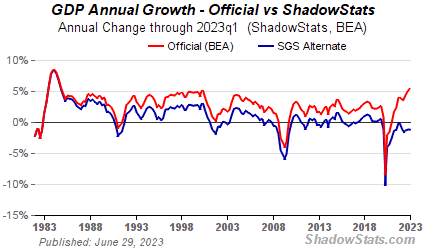
One of today's lead news stories reports that the NBER has determined that the "longest recession since the Great Depression" ended in June of 2009, after a "record" four consistent quarters of negative GDP growth.
That news, besides being a year untimely, would be great if it were true. Well, okay, it is true if you use the NBER and government definitions of economic data. The problem is that the data is skewed and just a bit unreliable.
First, the calculations of GDP are corrected for "inflation" by using the Consumer Price Index as the correction factor. The CPI was "tweaked" by Alan Greenspan back in the 1980's and doesn't measure the same fixed market basket of goods that was used previously, and makes allowances for people switching to alternatives if the price of one commodity increases. According to John William of Shadow Government Statistics (ShadowStats), who publishes comparisons between current practices and prior practice, the CPI reports about 3% lower than it did pre-Greenspan. As a result, the correction for inflation used to determine if the economy is growing or shrinking is off by about 3% too. The graph above shows the difference in the GDP as calculated by ShadowStats and the "official" version. When the line is below 0%, the economy is shrinking, and we're in a recession. By Williams' numbers, we've been in a recession since 2004, and we are still below the line.
2004 to 2010+ is about 24 consecutive quarters, give or take, or 60 months; 48 to be conservative. The longest "recession" during the Great Depression was only 43 months.
The second problem is that GDP, the principal measure of recessions, is based on government spending. The actual formula is GDP = C + I + G + (E - I) where C is consumer spending, I is gross investment, G is government spending, E is exports and I in imports. Keynesian economics calls for government intervention, either through monetary policy (lower Fed interest rates) or fiscal policy (government spending) during recessions. The theory is that increasing the supply of money will "stimulate" the economy and produce growth. The problem is that the spending itself is then counted as part of the growth. The C, I, and (E - I) sectors could still be shrinking, but the GDP is being propped up by the massive G. And the massive G is being funded by a huge deficit as the government takes on more and more debt to sustain the spending.
Even increases in C, I and E that occur when the government is spending through deficits, is artificial growth. As we saw when the home purchase subsidy and the cash for clunkers programs ended the "stimulus" ended with them.
And the spending, by putting more money (cash and cash substitutes) into the economy causes inflation, it just doesn't show up immediately in the CPI. The question that remains is whether the infusion of money will result in inflation or the high credit default rate will result in deflation first.
That, and there's a big question about whether the tax increases necessary to pay off the debt will go down well with the voters.
(Chart courtesy of Shadow Government Statistics.)
Comments